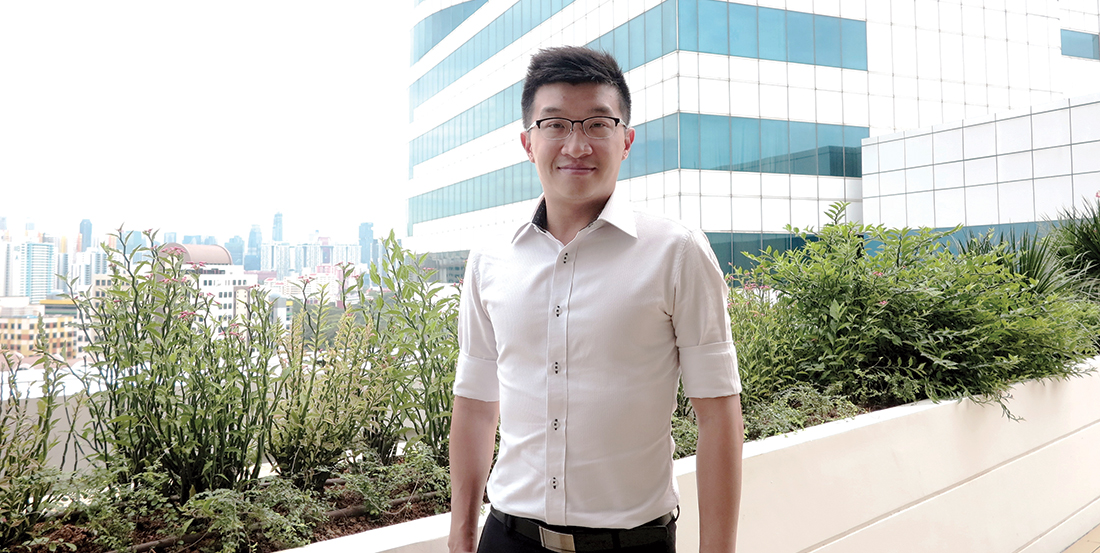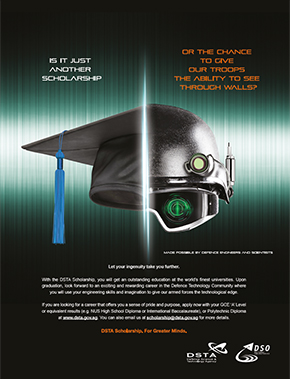W hen we think of our nation’s defence, the Singapore Armed Forces (SAF) readily springs to mind. What we do not draw our attention to as quickly is the community of defence engineers and scientists in the Defence Science and Technology Agency (DSTA), DSO National Laboratories (DSO), Centre for Strategic Infocomm Technologies and the logistics organisations of the SAF. This community forms the bedrock of our strong defence technology capabilities.
This community includes Gan Hao Yi, an Engineer at DSTA’s Land Systems Programme Centre, and Yap Yong Keong, a Defence Research Engineer at DSO’s Engineering Division. As DSTA scholars, both Hao Yi and Yong Keong tell us how they contribute to Singapore’s defence through the application of science and technology, and the boundless opportunities they have received with the DSTA Scholarship.
What sparked your interest in engineering, science and technology?
Gan Hao Yi: I have been fascinated by science and technology since a young age. I vividly recall a robotics workshop my classmates and I attended in secondary school, where we had to programme a robot and facilitate its manoeuvrability around a cluttered classroom. We managed to fulfil all the requirements of the programme with the guidance of our teacher, and this gave me a great sense of achievement. This incident certainly spurred my interest in science and technology, which led me to pursue a career in engineering.
Yap Yong Keong: My interest in building things was also ignited at a young age. I rediscovered this passion during the projects I did while I was in university. Building solar chargers and hacked toy helicopters in school truly reminded me of the satisfaction I got from seeing plans come alive, and prompted me to pursue a career where I knew I could feel the same sense of reward continuously.

Gan Hao Yi
DSTA Scholar
Designation:
Engineer, Land Systems Programme Centre, DSTA
Tell us about what you do at work today.
Hao Yi: As an Engineer at DSTA’s Land Systems Programme Centre, I apply the latest technologies to support the SAF in the development and delivery of advanced robots. My job is exciting as the field of robotics holds significant potential in changing the way the SAF operates and fights. Robots can be used to keep soldiers out of harm’s way in dangerous missions, and allow the SAF to operate with a leaner force. My projects involve integrating robotics technologies and systems on SAF platforms. These robots take on tasks such as autonomous navigation, leader-follower behavior and obstacle avoidance. I also have the opportunity to work with counterparts from other public service agencies on robotic systems that could support the Smart Nation initiative.
One memorable episode I have had at work was the opportunity to attend a robotics exhibition and conference in the US. The event featured workshops by leading robotics scientists, and a trade show showcasing robotics systems and components from more than 570 international exhibitors. This was an eye-opening experience – I got to discuss the latest robotics trends and technologies with fellow robotics professionals and enthusiasts from all around the world!
Yong Keong: My primary work in DSO is to design electronic circuits that are very small – smaller than a five-cent coin – which make a big difference in various defence systems. I get the opportunity to work closely with research and engineering experts to conceptualise new ideas, and translate them into reality through simulations and laboratory trials.
I will never forget the time when I looked at the first chip I designed under a microscope, right after it came back from the manufacturing house. At that point, I was amazed by how the knowledge and skills I gained from school were converted to a very tangible product!
Share with us about your undergraduate experiences.
Hao Yi: I chose to pursue my bachelor’s degree in Electrical and Electronics Engineering at Imperial College London, UK. My degree exposed me to a wide spectrum of engineering subjects such as robotics, power and energy, communications and software engineering. Under the DSTA Scholarship, I was also given the opportunity to complete my Master of Science in Management Science and Engineering at Stanford University in the US. This course offered me a unique mix of technical and project management modules which are useful to my career in DSTA. The close ties between the university and Silicon Valley firms also provide students with abundant opportunities to interact and work with some of the technology industry’s most brilliant leaders, thinkers and pioneers.
As part of the DSTA Scholarship, I had the opportunity to intern at DSTA’s Systems Management Programme Centre. I was part of a team that conducted a study on the power network performance at SAF camps, and proposed ways to improve their reliability. My internship allowed me to apply my engineering skills and knowledge from textbooks to address complex real-world problems, and gave me many insights into the work of defence engineers, which is diverse and often requires multidisciplinary expertise.

Yap Yong Keong
DSTA Scholar
Designation:
Member of Technical Staff,
Engineering Division, DSO National Laboratories
Yong Keong: I applied to UC Berkeley in the US because I wanted to tap on its strength in its renowned electrical engineering programme. The university ranks among the top three electrical engineering schools and sits right smack across a bay from Silicon Valley, home to all things high-tech. The learning environment there was extremely conducive and collaborative.
During my undergraduate days, I did an internship with DSTA. My job scope was to assess whether a new technology was ready for use in the SAF. This was my opportunity to witness how things worked in the defence industry, and how individuals contributed to the industry’s goals. This certainly prepared me for my current job.
What qualities should aspiring DSTA scholars possess?
Hao Yi: They should first have a passion for science and technology. They should also be deeply interested in and keep abreast of the latest developments in the field. Aspiring DSTA scholars must also take pride in contributing to Singapore’s defence and security. Passion, commitment to lifelong learning and pride in their work will allow them to relentlessly pursue the best engineering solutions for the SAF and our nation’s defence.
Yong Keong: I believe aspiring DSTA scholars must be both patient and determined to reach their goals. Determination is required because one may encounter a lot of unexpected roadblocks in the field of research and development. On the other hand, patience is paramount because tangible results take time to show, usually after a period of months or even years!
I would also like to conclude by saying that the opportunity to look at how our technology works is mind-blowing. It certainly is a huge privilege to be able to look and marvel at the design of systems – all to keep Singapore safe from harm and potential threats.

